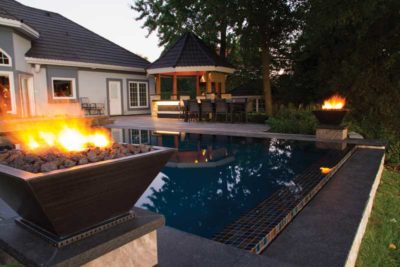
An automation system was installed to control all of the backyard elements, including the pool circulation equipment, heaters, lights, and water/fire features. The system has the ability to be remotely controlled by a mobile device such as a smartphone or tablet and the ability for off-site monitoring of the system by a service technician. With the use of variable-speed pumps and automation control, the speed of the pumps can be controlled to minimize energy consumption while still maintaining an adequate turnover rate to recirculate the water through the filtration system. Cartridge filtration was used for its filtering capacity and its lack of need for backwashing, which further reduces overall water wastage. Energy-efficient coloured light-emitting diode (LED) lights were used for their low-voltage requirement and long-life expectancy.
With all infinity pool and perimeter overflow designs, an overflow or surge tank is required. The purpose of this tank is to collect and recirculate the water that passes over the vanishing or overflow edge, as well as collect any rainfall and water from bather displacement. This collection reservoir may be a visible component of the pool such as below the weir wall of a vanishing edge or an underground tank. For this design, the preferred method was to construct a concrete tank adjacent to the pool structure concealed beneath the patio. Since this pool was incorporating a perimeter overflow, the decking surrounding the pool was required to slightly slope towards the water’s edge. This allows for any water that may collect on the deck surface—from splash out or precipitation—to flow into the small gap between the deck surface and collect in the surge tank, where it is chemically treated and recirculated into the system, again reducing the amount of makeup water required.

It is common for residential home builders to incorporate green technologies and products into their home designs. That said, the design of pools and spas should be no different, as they are an extension of the home’s interior living space. All pools should be designed to be as energy efficient as possible by means of completely insulating the structure, incorporating an automatic cover, using variable-drive pumps and cartridge filtration, as well as some form of automation control.
The vanishing illusion
An early phase of the pool concept proposed by Charette set the elevation of the new pool at the same elevation as the existing one. In this case, the pool would achieve the vanishing-edge illusion only from the perspective of bathers in the water. From most other vantage points—such as the deck or from the home—the seamless view between the pool and river would be interrupted by a section of grass. That said, the Willis design team was well aware of the importance of establishing the correct elevation for a vanishing-edge watershape. A simple grade error of a few inches could result in a pool not vanishing as intended. When designing or constructing any vanishing-edge project, it is best to discuss with the client the ideal view they wish to obtain and position the pool and elevation accordingly. A few simple questions can save a designer and contractor a world of headache and embarrassment, not to mention the liability or the cost it would entail to modify a failed vanishing-edge project. Therefore, ask the client if the pool should appear to vanish while:
- swimming;
- sitting on a chair on the patio or deck; and/or
- inside the home (sitting, standing, or both?)
By raising this pool’s elevation and re-grading the landscape, it was possible to achieve a seamless transition between the pool and river from all areas inside the house, including the living room, dining room, and entertaining areas.






